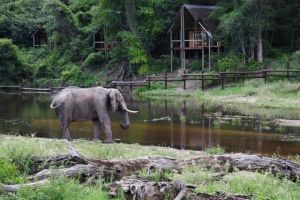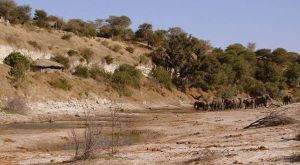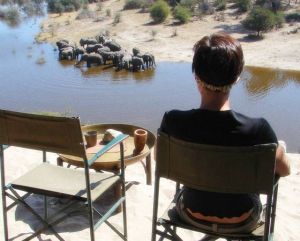From wildlife perspective it often seems that there is only bad news out there, loss of habitat, drought, human encroachment and poaching. There are very few feel good or success stories in Africa,
Botswana bucks the trend. It is the shining light in Africa, through responsible governance and wise use of its natural resources
Now an incredible natural phenomena is unfolding…
Savute Channel flows again!
The Savute River has been the focus of many films and documentaries, a river that the early traders used to water their cattle on their way up north to the abattoirs in Livingston and Lusaka, a small oasis amidst the arid Kalahari sands that cover most of northern Botswana.
The river has a history of flowing and drying up with many “experts” suggesting Teutonic movement and the rift valley extension being the reasons why. In recent times it flowed from 1959 to 1982 and while the exact reasons for the drying up are unclear, evidence suggests that far from any human interference or earth adjustments – it needs years of exceptional Angolan rains to get it flowing again.
Those sceptics who believed it would never flow again in our lifetime have been proved wrong, the Eden of years gone by is beginning to rejuvenate and return to life. Good rains in the Angolan catchment area over the past few years have seen higher then normal quantities of water beings discharged down the Kwando and Linyanti rivers. This has slowly filled and backed up into the Linyanti lagoons – to the extent that the “stolen river” has started to flow again. It has taken almost two years to meander down the parched Savute channel, seeping and saturating the dry riverbed along its way. In April of this year the river reached its destination, the incredible Savute marsh has now got water again after nearly 30 years.
The phenomena is not to be missed, where once concerned individuals used to truck water in for the starving animals left behind, already fish eagles, hippo, crocodiles and other water dependant species are back. Animals that used to migrate up to the Linyanti River during the dry season are now staying year round. Soon species like waterbuck and reedbuck will return. The marsh is now a lush green pasture supporting fantastic numbers of game.
No One knows how long the river will continue to flow, visit Savute now for a Botswana holiday of a lifetime.
The Boteti River flowing through the Makgadigadi NP
Thousands of years ago the Zambezi and Okavango Rivers used to flow into a huge inland sea called the Makgadigadi. Over time the climate changed and the area got drier and drier. The Zambezi River changed course and made its way to the Indian Ocean.
The Okavango still drains into the Makgadigadi and until 30 or so years ago, there used to be a ferry crossing on the Boteti River at Rakops. The dusty village had a thriving fishing community and makoros were the preferred means of transport. This all changed in the late seventies when the rivers started to dry and since then generations of children have grown up never having sat in a makoro or seen the river with water.
The great thirst (and some questionable fence alignments) was responsible for the demise of one of the largest wildebeest and zebra migrations ever (equalling that of Tanzania) The life sustaining river turned to dust and animals and humans only survived where shallow wells could be dug.
Things got to crises proportions, human and animal conflict reached breaking point around the few drinking points and it was decided to fence in the national park and to provide water holes to prevent total decimation of the remnant zebra and wildebeest herds. The fencing of the park stopped the human/wild animal conflict but exacerbated the dire situation for the animals “fenced in” They were safe from hunting but had no water. Some emergency wells we drilled but basically it was left to the private lodge
operators to step up and take action.
This they did by working tirelessly – sometimes for days on end to make sure the animals had water to drink.
2009 brought a new dawn; good rains in Angola ensured that the Okavango Delta had its highest water since the early 80’s. This in addition to good local rainfall meant that the delta flood made it almost 60km down the Boteti River. The river held water the whole year and this year the flood has been even better. Although only certain portions of the river are accessible to wildlife, the Boteti has been given a new lease on life and many thousands of animals saved.
Game viewing along the river in the dry winter months is unbelievable, apart from the remnant pod of hippos and crocodiles that stayed alive by living in caves, there is now an abundance of game, herds of zebra and wildebeest continue to get bigger. Rhino, giraffe, elephant and many other species of game that almost died out are back and thriving.
Come and share this fairy tale that is called the Boteti.


